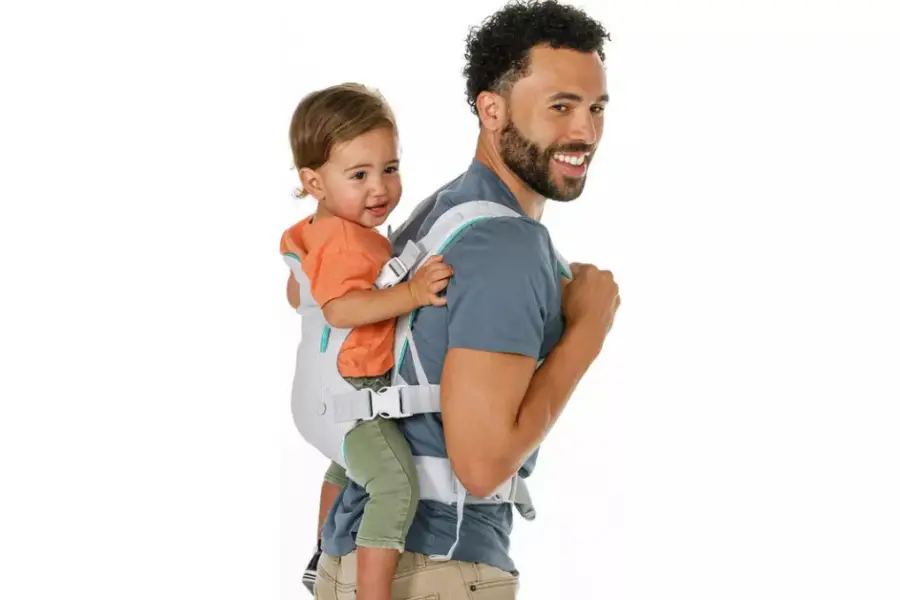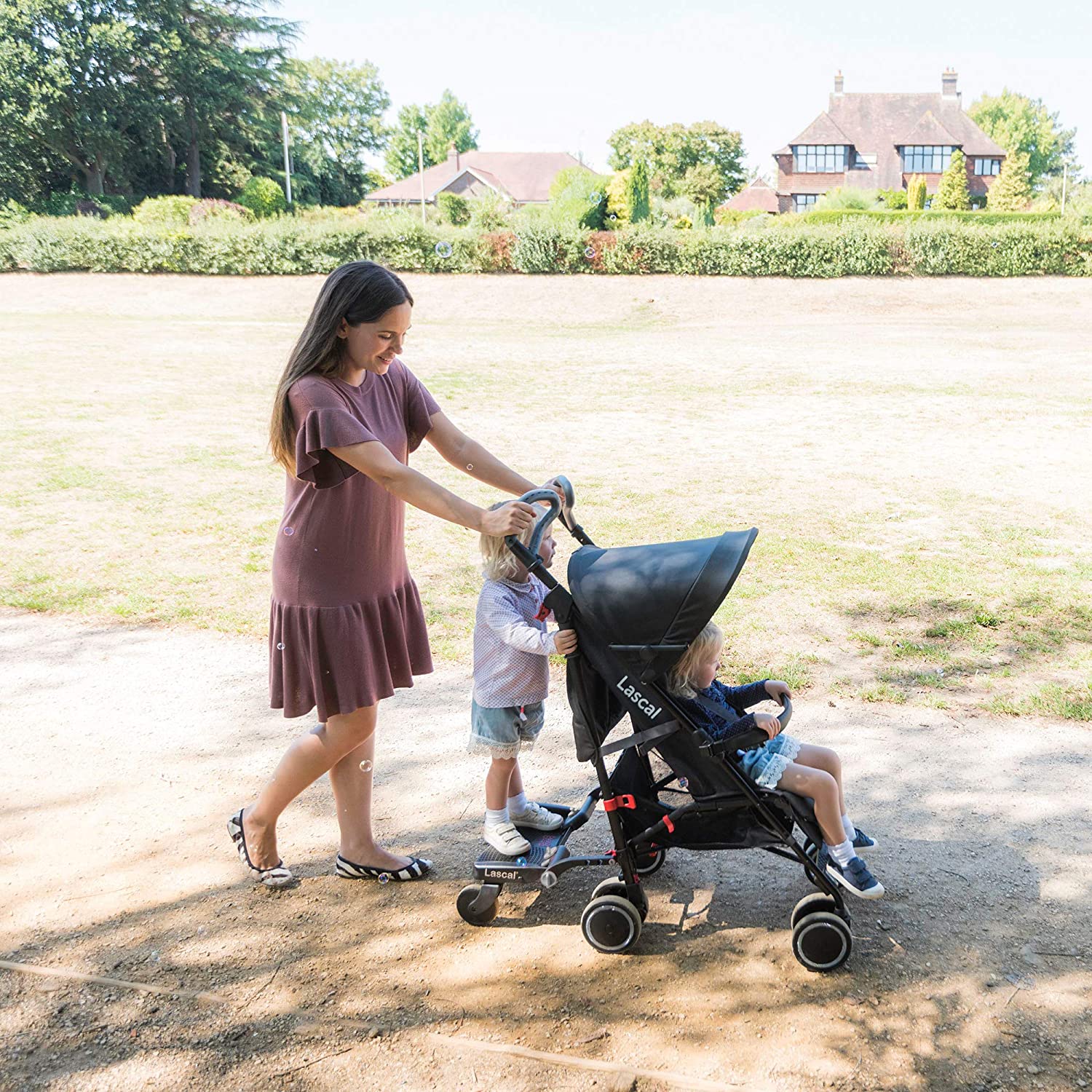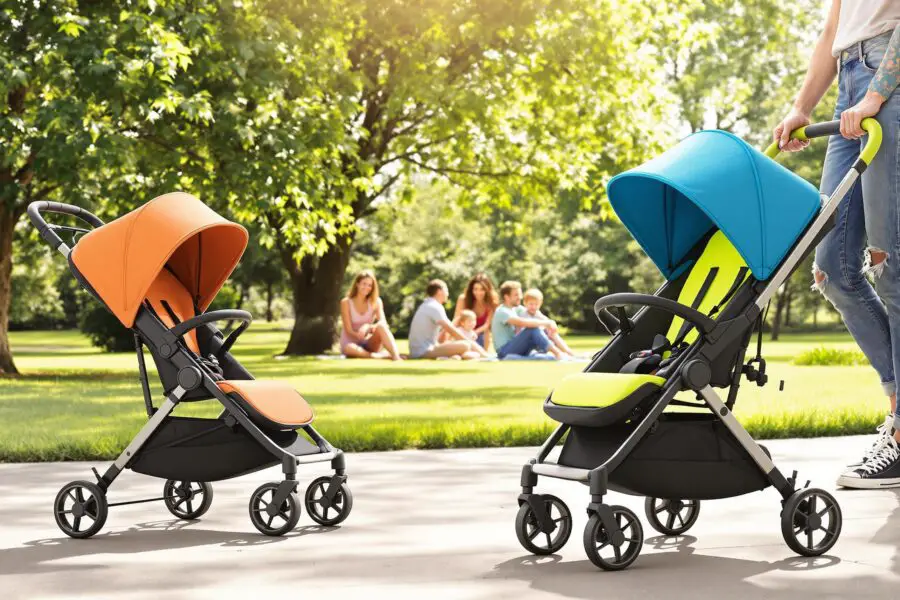Your child’s safety comes first, especially when using a backpack carrier. Here’s what you need to know to make the best choice:
- Key Safety Features: Look for a sturdy frame, a secure five-point harness, and a stable kickstand to prevent accidents.
- Certifications Matter: Choose carriers that meet U.S. safety standards like ASTM and CPSC compliance.
- Materials: Opt for non-toxic, durable fabrics (e.g., OEKO-TEX certified or GOTS organic).
- Weather Protection: Features like UPF 50+ canopies and water-resistant fabrics shield your child from the elements.
- Inspection Routine: Before each use, check straps, buckles, and the frame for wear or damage.
- Hip Health: Ensure the carrier supports the ergonomic “M” position, certified by the International Hip Dysplasia Institute (IHDI).
Quick Safety Checklist
| Feature | What to Check |
|---|---|
| Harness System | Secure, adjustable five-point harness |
| Frame | Lightweight, sturdy aluminum or steel |
| Kickstand | Stable, locks securely in place |
| Materials | Non-toxic, tear-resistant fabrics |
| Weather Features | Sun canopy, ventilation, water-resistance |
| Certifications | ASTM, CPSC, IHDI |
Always inspect your carrier, follow age and weight guidelines, and consult a pediatrician if needed. A safe carrier means peace of mind for you and comfort for your child.
Are Baby Carriers Safe? What You Need to Know
Safety Design Elements
When choosing a backpack carrier, safety boils down to three key design features: a sturdy frame, a secure harness system, and a reliable kickstand. Each of these components plays a crucial role in protecting your child and ensuring a safe experience. Let’s break them down to help you make the right choice.
Strong Frame Construction
The backbone of a safe backpack carrier is its frame. Most carriers are built with lightweight aluminum or tough steel, materials known for their strength and durability. These frames are designed to handle children weighing anywhere from 16 to 50 pounds [1]. A well-built frame not only provides structural support but also ensures the weight is evenly distributed, making it more comfortable for both you and your child.
Safety Harness System
The harness system acts as your child’s primary restraint, keeping them secure during use. A reliable five-point harness includes the following components:
| Harness Component | Purpose |
|---|---|
| Shoulder Straps (2) | Prevent forward slipping |
| Thigh Straps (2) | Keep the lower body in place |
| Crotch Strap (1) | Stops downward sliding |
“Carriers with only a lap belt separate from shoulder and crotch straps should be avoided as they create openings large enough for a child to slip through”, advises the Consumer Product Safety Commission [7].
Look for a harness with adjustable straps and child-proof buckles. The chest plate should sit at armpit level, fitting snugly to keep your child secure while still allowing them to breathe comfortably.
Kickstand Safety
A dependable kickstand is critical for safe loading and unloading. Here’s what to look for in a good kickstand:
- Locks firmly in both the open and closed positions
- Offers a wide, stable base to prevent tipping on uneven surfaces
- Includes non-slip feet for added grip
- Opens and closes smoothly without creating pinch points
Before buying, test the kickstand on different surfaces to ensure it provides stability. A well-designed kickstand should keep the carrier balanced, even if your child moves or shifts their weight [6].
Safe Materials and Fabrics
While design ensures your child’s security, the materials used in a carrier play an equally important role in durability and shielding against external hazards. Today’s carriers are crafted with materials that meet strict safety standards, offering both comfort and resilience.
Non-Toxic Fabric Standards
According to the Juvenile Products Manufacturers Association, over 90% of high-quality baby carriers are now made with materials rigorously tested for harmful substances. When shopping for a carrier, look for certifications that guarantee safety and eco-friendliness.
| Certification | What It Ensures | Why It’s Important |
|---|---|---|
| OEKO-TEX Standard 100 | Free from harmful substances | Safe for direct contact with your baby’s skin |
| GOTS | Organic processing of fibers | Ensures no toxic chemicals in natural materials |
| GREENGUARD | Low chemical emissions | Promotes better indoor air quality |
| CPSC Compliance | Meets federal safety standards | Confirms adherence to essential safety regulations |
The Consumer Product Safety Commission (CPSC) also mandates that frame carriers be free from hazards like sharp edges, small detachable parts, and lead-based paint.
Strong and Protected Materials
Non-toxic fabrics ensure safe contact, but the overall durability of the carrier depends on the strength of its materials. Reliable backpack carriers often feature:
- Ripstop nylon or polyester for tear resistance
- Aluminum frames for lightweight yet sturdy support
- EVA foam padding to resist moisture and inhibit bacterial growth
- Monofilament threads with reinforced stitching to maintain structural integrity
A 2023 Consumer Reports study revealed that 78% of parents prioritize material safety in their baby carriers. To keep your carrier in top condition:
- Regularly inspect for wear, fraying, or damage
- Follow the manufacturer’s cleaning instructions
- Store the carrier out of direct sunlight to prevent material degradation
For weatherproofing, opt for carriers treated with PFC-free DWR (durable water repellent) finishes. Silicone-based or PFC-free treatments provide effective water resistance while maintaining fabric breathability, without relying on harmful chemicals.
Materials to Avoid
When selecting a carrier, steer clear of materials containing:
- PVC with phthalates
- Brominated flame retardants
- Formaldehyde-treated fabrics
- Azo dyes
- PFAS (per- and polyfluoroalkyl substances)
These substances are linked to health risks and should not be present in a quality carrier. Always confirm that the carrier you choose meets current safety standards, especially if buying second-hand or from regions with less strict regulations. Your baby’s safety starts with informed choices.
Weather and Safety Features
Premium carriers are stepping up their game when it comes to weather protection. In fact, 78% of premium carriers included weather protection features in 2023, a notable jump from just 45% in 2018 [7].
Weather Protection
Modern premium carriers are designed to shield little ones from the elements without compromising comfort. One standout feature is the UPF 50+ rated sun canopy, capable of blocking about 98% of harmful UV rays [5]. This is especially important since the American Academy of Pediatrics highlights that infants can suffer sunburn after just 15 minutes of direct sunlight [2].
Here’s a breakdown of some key weather protection features and how they help:
| Feature | Protection Provided | Extra Benefits |
|---|---|---|
| UPF 50+ Canopy | Shields 98% of UV rays | Adjustable for personalized sun coverage |
| Water-Resistant Fabric | Keeps out light to moderate rain | Breathable material ensures comfort |
| Ventilation Panels | Controls temperature | Reduces overheating while keeping the baby protected |
| Wind Barriers | Guards against wind | Can be deployed or retracted as needed |
| Mesh Side Panels | Improves air circulation | Zippable for added warmth in cooler weather |
These features not only make outdoor adventures safer but also ensure parents can adapt to changing weather conditions with ease.
Night Safety Features
When daylight fades, premium carriers are ready to keep families visible and safe. Many models now incorporate reflective materials, such as 3M Scotchlite™, which can be seen from over 500 feet away and provide up to 180 degrees of visibility [4].
To ensure full coverage, reflective elements are placed at various heights for 360-degree visibility. These materials are built to last, retaining their effectiveness for 3–5 years thanks to heat-bonding or specialized stitching that prevents peeling.
For added safety, some carriers offer attachment points for clip-on safety lights or pockets for light sticks. Adjustable zippered mesh panels also let parents manage airflow, ensuring comfort while maintaining protection in different weather conditions [8].https://app.seobotai.com/banner/inline/?id=sbb-itb-edcd6d4
Safety Checks and Care
Safety Inspection Steps
Regular safety checks are essential to keep your backpack carrier in top condition. Even with sturdy materials and solid design, consistent inspections ensure everything stays safe and reliable. Before each use, take a moment to visually inspect all the key components.
| Component | What to Check | Signs of Wear or Damage |
|---|---|---|
| Straps | Check for tension and strength | Look for fraying, discoloration, or stretching |
| Buckles | Ensure secure latching and stability | Watch for cracks, loose parts, or difficulty clicking |
| Frame | Look for structural soundness | Notice any bends, cracks, or loose joints |
| Fabric | Inspect material condition | Check for tears, weak spots, or worn seams |
| Kickstand | Test the locking mechanism | Be wary of stiffness or improper locking |
Make it a habit to do a quick check before every use and a more detailed inspection at least once a month. Pay extra attention to high-stress areas, like where straps connect to the frame or where buckles are attached. These simple steps can help prevent issues and ensure your carrier stays safe for the long haul.
Safe Cleaning Methods
Keeping your backpack carrier clean not only makes it look good but also helps maintain its safety features. Here’s how to clean it without compromising its durability:
- Spot Cleaning
Use mild soap and lukewarm water for small stains. Stay away from harsh chemicals that might weaken the fabric. - Deep Cleaning
Detach any removable fabric parts and follow the manufacturer’s care instructions. Most carriers allow for gentle hand washing or a delicate machine cycle with cold water. - Drying
Always air-dry your carrier in a shaded, well-ventilated area to protect UV coatings. Avoid direct sunlight, which can cause fading or damage. - Maintenance Tips
- Test cleaning solutions on a hidden spot first.
- Avoid soaking metal parts to prevent rust.
- Clean spills immediately to avoid staining.
- Store your carrier in a cool, dry place away from sunlight.
- Ensure everything is fully dry before putting it away.
Once you’ve cleaned and reassembled the carrier, double-check all safety features to make sure they’re working properly. A little care goes a long way in keeping your carrier safe and functional.
Safety Standards
Safety Testing Standards
Backpack carriers are required to meet stringent safety standards set by the Consumer Product Safety Commission (CPSC) under federal regulation 16 CFR § 1228. These regulations include ASTM F2549, which provides detailed guidelines for testing structural integrity and key safety features.
| Test Category | Requirements | Purpose |
|---|---|---|
| Structural Integrity | Weight-bearing tests with maximum load | Ensures the frame can support a child without failure |
| Restraint System | Five-point harness testing | Confirms the child is securely restrained |
| Stability | Kickstand and balance assessment | Reduces the risk of tipping when stationary |
| Material Safety | Chemical content and durability testing | Ensures compliance with chemical safety regulations |
Manufacturers put carriers through rigorous testing under real-world conditions, such as:
- Load-bearing capacity: Evaluating with weights exceeding the recommended child weight.
- Restraint durability: Repeatedly buckling and unbuckling to ensure long-term reliability.
- Impact resistance: Conducting drop tests to check the frame's ability to withstand impacts.
- Material safety: Ensuring all components meet federal standards for lead and chemical content.
“According to Consumer Reports, only carriers that pass ASTM F2549 and are JPMA certified are recommended for purchase in the U.S. market” [7].
In addition to these tests, it's crucial that carriers support healthy hip development for infants and young children.
Hip Health Standards
Proper hip support is just as vital as structural safety. The International Hip Dysplasia Institute (IHDI) has created guidelines to ensure backpack carriers promote healthy hip development by maintaining an ergonomic “M” position. This position helps support the natural development of an infant’s hips.
Key IHDI Requirements:
- Thighs must be fully supported.
- Knees should be positioned higher than the hips.
- Legs should naturally wrap around the carrier's body.
- Hip joints should have freedom of movement.
Carriers that meet IHDI standards incorporate specific design elements:
| Feature | Benefit | Implementation |
|---|---|---|
| Wide Seat Base | Evenly distributes weight | Extends from knee to knee |
| Adjustable Width | Adapts to a growing child | Offers multiple position settings |
| Ergonomic Design | Maintains the “M” position | Features a curved seat structure |
IHDI certification has become a key factor for many manufacturers, as parents increasingly prioritize products designed to support healthy hip development. Look for carriers with explicit IHDI certification to ensure they have been evaluated for this purpose.
Safety standards are continuously reviewed and updated based on new research and data. The CPSC most recently revised its frame carrier safety requirements in September 2022 [3].
Conclusion
When choosing a backpack carrier, prioritize safety features and certifications to ensure the well-being of both you and your child.
Here’s a breakdown of key safety considerations:
| Safety Category | Critical Requirements | Verification Method |
|---|---|---|
| Structural Safety | ASTM F2549 compliance; sturdy frame | Check for certification label |
| Harness System | Secure 5-point adjustable harness | Perform a physical inspection |
| Hip Health | Ergonomic design for proper hip support | Review product specifications |
| Material Safety | Non-toxic materials; CPSC standard compliance | Examine manufacturer documentation |
Before every use, inspect the carrier thoroughly. Check the frame, straps, and buckles for any signs of wear or damage. Follow the manufacturer's guidelines for cleaning and storage to maintain its condition.
To maximize safety, ensure your carrier meets all the critical dimensions mentioned above: strong structural design, a secure harness system, proper hip support, and safe, non-toxic materials.
As safety standards evolve with new research and testing methods, stay informed by reviewing the latest manufacturer updates and seeking advice from certified childcare safety experts. Keep this checklist accessible to ensure your carrier remains a safe and reliable choice.
FAQs
×
What features should I look for in a backpack carrier to ensure it promotes healthy hip development for my child?
To promote healthy hip development for your child, opt for a backpack carrier that positions their legs in an M-shape – with their knees slightly higher than their hips. This design minimizes stress on growing joints and aligns with advice from pediatric specialists.
You’ll also want a carrier with adjustable seat widths and straps. These features ensure a secure, comfortable fit as your child grows. Choose materials that are both soft and durable, offering comfort while supporting proper posture for your little one.×
How can I make sure a backpack carrier's materials are safe and non-toxic for my child?
To make sure a backpack carrier is made from safe, non-toxic materials for your child, check for certifications like CPSIA compliance or OEKO-TEX Standard 100. These labels confirm that the materials have been tested and meet strict safety standards, ensuring they are free from harmful substances such as lead, phthalates, and formaldehyde.
You should also review the product description or packaging for specifics about the materials. Carriers crafted from organic cotton, GOTS-certified fabrics, or other baby-safe options are ideal. If the information isn't clear, don’t hesitate to contact the manufacturer directly to ask about their safety testing and material sourcing practices.×
What safety checks should I do before using a backpack carrier?
Before strapping on a backpack carrier, take a moment for a quick safety check to keep your child secure and comfortable. Begin by examining all straps and buckles – make sure they're intact, securely fastened, and adjusted to fit your child properly. Next, look over the carrier’s frame and stitching for any signs of damage, like fraying or loose parts, that might affect its stability.
Check that the seat and harness are correctly positioned to support your child without limiting their movement or cutting off circulation. Finally, ensure the carrier is clean and free of debris. If it includes a kickstand, test it to confirm it locks firmly into place when needed. Making these checks a habit will ensure your adventures are both safe and enjoyable for you and your child.



